Investigating the Ability of Road Specifications to Discriminate the Rutting Behavior of Rubberized Asphalt Mixtures in Italy †
Abstract
:1. Introduction
Aim of the Study
2. Materials and Methods
2.1. Materials
Specimen Preparation
2.2. Methods
2.2.1. Conventional Characterization (QA/QC—Italian Road Authority Requirements)
Conventional IDT Testing
2.3. Additional Rutting Characterization
2.3.1. Basic Level
High-Temperature Indirect Tensile Strength (HT-IDT) Evaluation
2.3.2. Advanced Level
Flow Number (FN) Assessment
Stress Sweep Rutting (SSR) Assessment
Determination of Permanent Strain Using Shift Model
Rutting Strain Index(RSI) Quantification
3. Results and Discussion
3.1. QA/QC Assurance—Italian Road Authority Requirements
3.1.1. Conventional Characterization
Volumetric Analysis
3.1.2. Conventional IDT and CTI Analysis
3.2. Summary of the Conventional Characterization
3.3. Additional Rutting Characterization
3.3.1. Basic-Level Rutting Behavior
High-Temperature (HT-IDT) and CTI Analysis
3.3.2. Advanced-Level Rutting Behavior
Flow Number (FN) Analysis
Stress Sweep Rutting Test (SSR) and RSI Results
4. Summary of the Results
- Similarities were found for both the energy compaction method for quality assurance and quality control (QA/QC) by the Italian road authorities and 5.0% target air voids. The difference observed was 1.89 and 2.33%.
- The difference in the IDT at 25 °C for QA/QC using ITS and CTI test parameters were 35% and 70%, respectively.
- The basic-level HT-IDT at 54 °C appears to play a pivotal role in improving the material’s ability to resist permanent deformation by means of additional rutting behavior (a 73.0% difference was observed), while a difference of 77% in HT-CTI was observed.
- With the rutting behavior measured using the advanced-level approach, the FN 54.0 °C showed a difference of 34%. The SSR at both low (20.0 °C) and high (54.0 °C) temperatures provided differences of 9.0% and 24.0%, respectively, at 600 cycles, and a deviatoric stress level of 896 KPa.
- The RSI analysis showed that a clear transformation from a standard traffic status to an exceptional capability to withstand heavy traffic is indicative of the pronounced benefits of incorporating ECR into conventional asphalt mixtures. The difference in the RSI (%) was 40.0% between the conventional and rubberized asphalt mixtures.
5. Conclusions and Recommendations
- In terms of the volumetrics, the following was concluded:
- o
- For conventional characterization, it can be concluded that the target air void study procedure as required for the performance analysis can be adopted instead of the energy compaction process.
- In terms of the mechanical properties, the following was concluded:
- o
- The conventional characterization for quality assurance and quality control (QA/QC) by the Italian road authorities showed a comparable difference (<35%) between the conventional and alternative paving materials (rubberized asphalt mixes) in terms of bearing capacity by means of the ITS. Instead, when looking at flexibility, by means of the CTI, the investigation always showed a huge difference (>70%) between the conventional and rubberized asphalt mixes.
- o
- The additional rutting behavior assessed at the basic level (by means of both HT-ITS and HT-CTI) always showed a huge difference (>70%) between the conventional and rubberized asphalt mixes.
- o
- A significant difference (>36% and <69%) between the conventional and alternative rubberized asphalt paving material mixes were found using the additional rutting behavior assessed at the advanced level (by means of AMPT).
Author Contributions
Funding
Institutional Review Board Statement
Informed Consent Statement
Data Availability Statement
Acknowledgments
Conflicts of Interest
References
- Meroni, F.; Flintsch, G.W.; Habbouche, J.; Diefenderfer, B.K.; Giustozzi, F. Three-level performance evaluation of high RAP asphalt surface mixes. Constr. Build. Mater. 2021, 309, 125164. [Google Scholar] [CrossRef]
- Islam, R.; Hossain, M.I.; Tarefder, R.A. A study of asphalt aging using Indirect Tensile Strength test. Constr. Build. Mater. 2015, 95, 218–223. [Google Scholar] [CrossRef]
- Du, Y.; Chen, J.; Han, Z.; Liu, W. A review on solutions for improving rutting resistance of asphalt pavement and test methods. Constr. Build. Mater. 2018, 168, 893–905. [Google Scholar] [CrossRef]
- Liao, H.; Tavassoti, P.; Sharma, A.; Baaj, H. Evaluation of rutting resistance and moisture susceptibility of high RAP content asphalt mixtures containing bio-based rejuvenators. Constr. Build. Mater. 2023, 401, 132859. [Google Scholar] [CrossRef]
- Xu, T.; Huang, X. Investigation into causes of in-place rutting in asphalt pavement. Constr. Build. Mater. 2012, 28, 525–530. [Google Scholar] [CrossRef]
- Chilukwa, N.; Lungu, R. Determination of layers responsible for rutting failure in a pavement structure. Infrastructures 2019, 4, 29. [Google Scholar] [CrossRef]
- Ghani, U.; Zamin, B.; Bashir, M.T.; Ahmad, M.; Sabri, M.M.S.; Keawsawasvong, S. Comprehensive study on the performance of waste HDPE and LDPE modified asphalt binders for construction of asphalt pavements application. Polymers 2022, 14, 3673. [Google Scholar] [CrossRef] [PubMed]
- Simpson, A.L.; Daleiden, J.F.; Hadley, W.O. Rutting analysis from a different perspective. Transp. Res. Rec. 1995, 1473, 9. [Google Scholar]
- Fwa, T.F.; Tan, S.A.; Zhu, L.Y. Rutting prediction of asphalt pavement layer using C-ϕ model. J. Transp. Eng. 2004, 130, 675–683. [Google Scholar] [CrossRef]
- Boz, I.; Habbouche, J.; Diefenderfer, S.D.; Coffey, G.; Seitllari, A.; Ozbulut, O.E. Evaluating the Rutting Potential of Asphalt Mixtures with Simple and Practical Tests. Transp. Res. Rec. J. Transp. Res. Board 2023, 03611981231207089. [Google Scholar] [CrossRef]
- Hong, F.; Chen, D. Evaluation of asphalt overlay permanent deformation based on ground-penetrating radar technology. J. Test. Evaluation 2016, 44, 1716–1723. [Google Scholar] [CrossRef]
- Fontes, L.P.; Trichês, G.; Pais, J.C.; Pereira, P.A. Evaluating permanent deformation in asphalt rubber mixtures. Constr. Build. Mater. 2010, 24, 1193–1200. [Google Scholar] [CrossRef]
- Zaumanis, M.; Poulikakos, L.; Partl, M. Performance-based design of asphalt mixtures and review of key parameters. Mater. Des. 2018, 141, 185–201. [Google Scholar] [CrossRef]
- Yazdipanah, F.; Ameri, M.; Shahri, M.; Hasheminejad, N.; Haghshenas, H.F. Laboratory investigation and statistical analysis of the rutting and fatigue resistance of asphalt mixtures containing crumb-rubber and wax-based warm mix asphalt additive. Constr. Build. Mater. 2021, 309, 125165. [Google Scholar] [CrossRef]
- Chaturabong, P.; Bahia, H.U. Mechanisms of asphalt mixture rutting in the dry Hamburg Wheel Tracking test and the potential to be alternative test in measuring rutting resistance. Constr. Build. Mater. 2017, 146, 175–182. [Google Scholar] [CrossRef]
- Vamsikrishna, G.; Singh, D. Comparison of Rutting Resistance of Plant Produced Asphalt Mixes Using Hamburg Wheel Tracker and Surrogate Simple Performance Tests: IDEAL-RT and HT-IDT. J. Mater. Civ. Eng. 2023, 35, 04023471. [Google Scholar] [CrossRef]
- Wang, D.; Baliello, A.; Pinheiro, G.d.S.; Poulikakos, L.D.; Tušar, M.; Vasconcelos, K.L.; Kakar, M.R.; Porot, L.; Pasquini, E.; Giancontieri, G.; et al. Rheological Behaviors of Waste Polyethylene Modified Asphalt Binder: Statistical Analysis of Interlaboratory Testing Results. J. Test. Eval. 2023, 51, 2199–2209. [Google Scholar] [CrossRef]
- Tušar, M.; Kakar, M.R.; Poulikakos, L.D.; Pasquini, E.; Baliello, A.; Pasetto, M.; Porot, L.; Wang, D.; Falchetto, A.C.; Dalmazzo, D.; et al. RILEM TC 279 WMR round robin study on waste polyethylene modified bituminous binders: Advantages and challenges. Road Mater. Pavement Des. 2023, 24, 311–339. [Google Scholar] [CrossRef]
- Li, H.; Jiang, H.; Zhang, W.; Liu, P.; Wang, S.; Wang, F.; Zhang, J.; Yao, Z. Laboratory and field investigation of the feasibility of crumb rubber waste application to improve the flexibility of anti-rutting performance of asphalt pavement. Materials 2018, 11, 1738. [Google Scholar] [CrossRef]
- Picado-Santos, L.G.; Capitão, S.D.; Neves, J.M. Crumb rubber asphalt mixtures: A literature review. Constr. Build. Mater. 2020, 247, 118577. [Google Scholar] [CrossRef]
- Giancontieri, G.; Hargreaves, D.; Presti, D.L. Are we correctly measuring the rotational viscosity of heterogeneous bituminous binders? Road Mater. Pavement Des. 2020, 21 (Suppl. 1), S37–S56. [Google Scholar] [CrossRef]
- Medina, J.G.; Giancontieri, G.; Presti, D.L. Quality control of manufacturing and hot storage of crumb rubber modified binders. Constr. Build. Mater. 2020, 233, 117351. [Google Scholar] [CrossRef]
- Giancontieri, G.; Hargreaves, D.; Partal, P.; Presti, D.L. Unlocking the Dual Helical Ribbon for rotational viscosity measurements of highly heterogeneous fluids. Mater. Des. 2024, 241, 112920. [Google Scholar] [CrossRef]
- Lo Presti, D. Recycled Tyre Rubber Modified Bitumens for road asphalt mixtures: A literature review. Constr. Build. Mater. 2013, 49, 863–881. [Google Scholar] [CrossRef]
- SpA, A. Capitolato Speciale D’Appalto-Norme Tecniche per l’esecuzione del Contratto Parte 2. Coordinamento Territoriale/Direzione IT. PRL. 2016. Available online: https://www.stradeanas.it/sites/default/files/CSA%20NT%207IMSS2019%20%20Budduso%27.pdf (accessed on 30 May 2024).
- Kim, D.; Kim, Y.R. Development of Stress Sweep Rutting (SSR) test for permanent deformation characterization of asphalt mixture. Constr. Build. Mater. 2017, 154, 373–383. [Google Scholar] [CrossRef]
- Ziari, H.; Divandari, H.; Hajiloo, M.; Amini, A. Investigating the effect of amorphous carbon powder on the moisture sensitivity, fatigue performance and rutting resistance of rubberized asphalt concrete mixtures. Constr. Build. Mater. 2019, 217, 62–72. [Google Scholar] [CrossRef]
- Raschia, S.; Tattolo, S.; Rilievi, A. Evaluation of high percentage of alternative aggregates for the production of hot mix asphalt surface layers. Road Mater. Pavement Des. 2023, 25, 56–71. [Google Scholar] [CrossRef]
- Ghani, U.; Milazzo, S.; Giancontieri, G.; Mignini, C.; Buttitta, G.; Gu, F.; Presti, D.L. Unveiling the Benefits of Engineered Crumb Rubber for Asphalt Mixtures via Performance-Related Characterization: Rutting Behavior. Eng. Proc. 2023, 36, 39. [Google Scholar] [CrossRef]
- Mallick, R.B. Use of Superpave gyratory compactor to characterize hot-mix asphalt. Transp. Res. Rec. J. Transp. Res. Board 1999, 1681, 86–96. [Google Scholar] [CrossRef]
- ANAS. I quaderni tecnici per la salvaguardia delle infrastrutture. Quad. Tec. 2019, 17, 76. [Google Scholar]
- Scotton, R. Il Riciclaggio a Freddo Nelle Pavimentazioni Stradali: Caratterizzazione Prestazionale di Diverse Miscele in Conglomerato Bituminoso Schiumato. 2013. Available online: https://www.politesi.polimi.it/handle/10589/97761 (accessed on 30 May 2024).
- Jeong, J.; Underwood, B.S.; Kim, Y.R. Rutting performance prediction using index-volumetrics relationships with stress sweep rutting test and Hamburg wheel-track test. Constr. Build. Mater. 2021, 295, 123664. [Google Scholar] [CrossRef]
- Zhang, Y.; Ma, T.; Ding, X.; Chen, T.; Huang, X.; Xu, G. Impacts of air-void structures on the rutting tests of asphalt concrete based on discretized emulation. Constr. Build. Mater. 2018, 166, 334–344. [Google Scholar] [CrossRef]
- Alavi, A.H.; Ameri, M.; Gandomi, A.H.; Mirzahosseini, M.R. Formulation of flow number of asphalt mixes using a hybrid computational method. Constr. Build. Mater. 2011, 25, 1338–1355. [Google Scholar] [CrossRef]
- Wang, H.; Zhan, S.; Liu, G.; Xiang, J. The effects of asphalt migration on the flow number of asphalt mixture. Constr. Build. Mater. 2019, 226, 442–448. [Google Scholar] [CrossRef]
- Ghanbari, A. Stress Sweep Rutting (SSR) Test: AMPT; North Carolina State University: Raleigh, NC, USA, 2018. [Google Scholar]
- Wang, Y.D.; Ghanbari, A.; Underwood, B.S.; Kim, Y.R. Development of preliminary transfer functions for performance predictions in FlexPAVE™. Constr. Build. Mater. 2021, 266, 121182. [Google Scholar] [CrossRef]
- Joumblat, R.; Masri, Z.A.B.A.; Al Khateeb, G.; Elkordi, A.; El Tallis, A.R.; Absi, J. State-of-the-art review on permanent deformation characterization of asphalt concrete pavements. Sustainability 2023, 15, 1166. [Google Scholar] [CrossRef]
- Lee, J.-S.; Lee, S.-Y.; Le, T.H.M. Developing performance-based mix design framework using asphalt mixture performance tester and mechanistic models. Polymers 2023, 15, 1692. [Google Scholar] [CrossRef] [PubMed]
- Kim, Y.R.; Ghanbari, A.; Underwood, S. Rutting Strain Index (RSI) Parameter for Asphalt Performance Engineered Mixture Design [Tech Brief]; Federal Highway Administration. Office of Research, Development, and Technology: Washington, DC, USA, 2021.
- Christensen, D.W.; Bonaquist, R.; Anderson, D.A.; Gokhale, S. Indirect tension strength as a simple performance test. Transp. Res. Circ. Number E-C068 2004, 44–57. [Google Scholar]
- Nguyen, H.T.; Tran, T.N. Effects of crumb rubber content and curing time on the properties of asphalt concrete and stone mastic asphalt using dry process. Int. J. Pavement Res. Technol. 2018, 11, 236–244. [Google Scholar] [CrossRef]
- Bennert, T.; Haas, E.; Wass, E. Indirect Tensile Test (IDT) to determine asphalt mixture performance indicators during quality control testing in New Jersey. Transp. Res. Rec. J. Transp. Res. Board 2018, 2672, 394–403. [Google Scholar] [CrossRef]
- Yu, H.; Shen, S. An Investigation of Dynamic Modulus and Flow Number Properties of Asphalt Mixtures in Washington State; Report No. TNW; Transportation Northwest (TransNow) UTC: Seattle, WA, USA, 2012.
- Shirini, B.; Imaninasab, R. Performance evaluation of rubberized and SBS modified porous asphalt mixtures. Constr. Build. Mater. 2016, 107, 165–171. [Google Scholar] [CrossRef]
- Ghanbari, A.; Underwood, B.S.; Kim, Y.R. Development of a rutting index parameter based on the stress sweep rutting test and permanent deformation shift model. Int. J. Pavement Eng. 2022, 23, 387–399. [Google Scholar] [CrossRef]
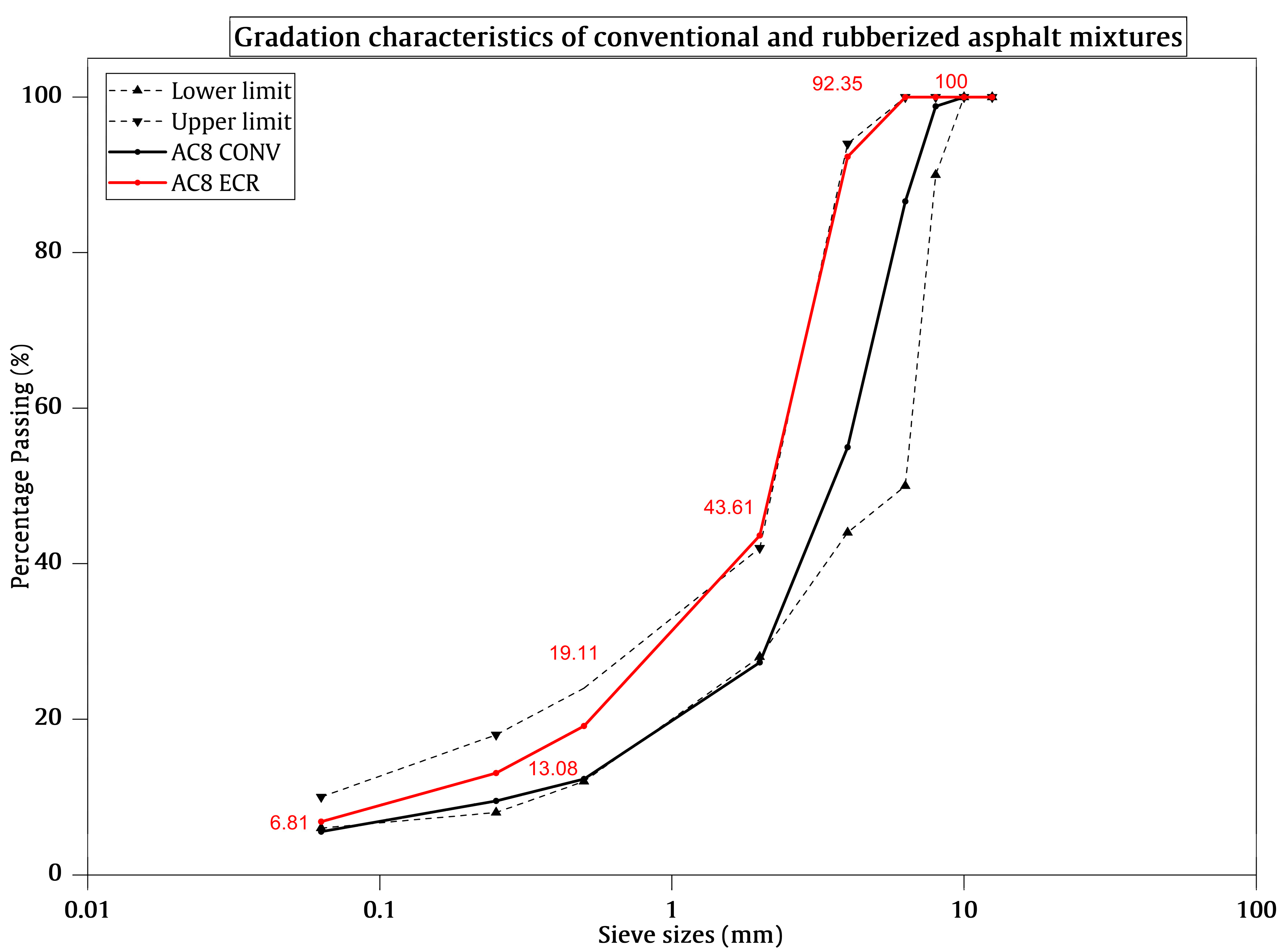
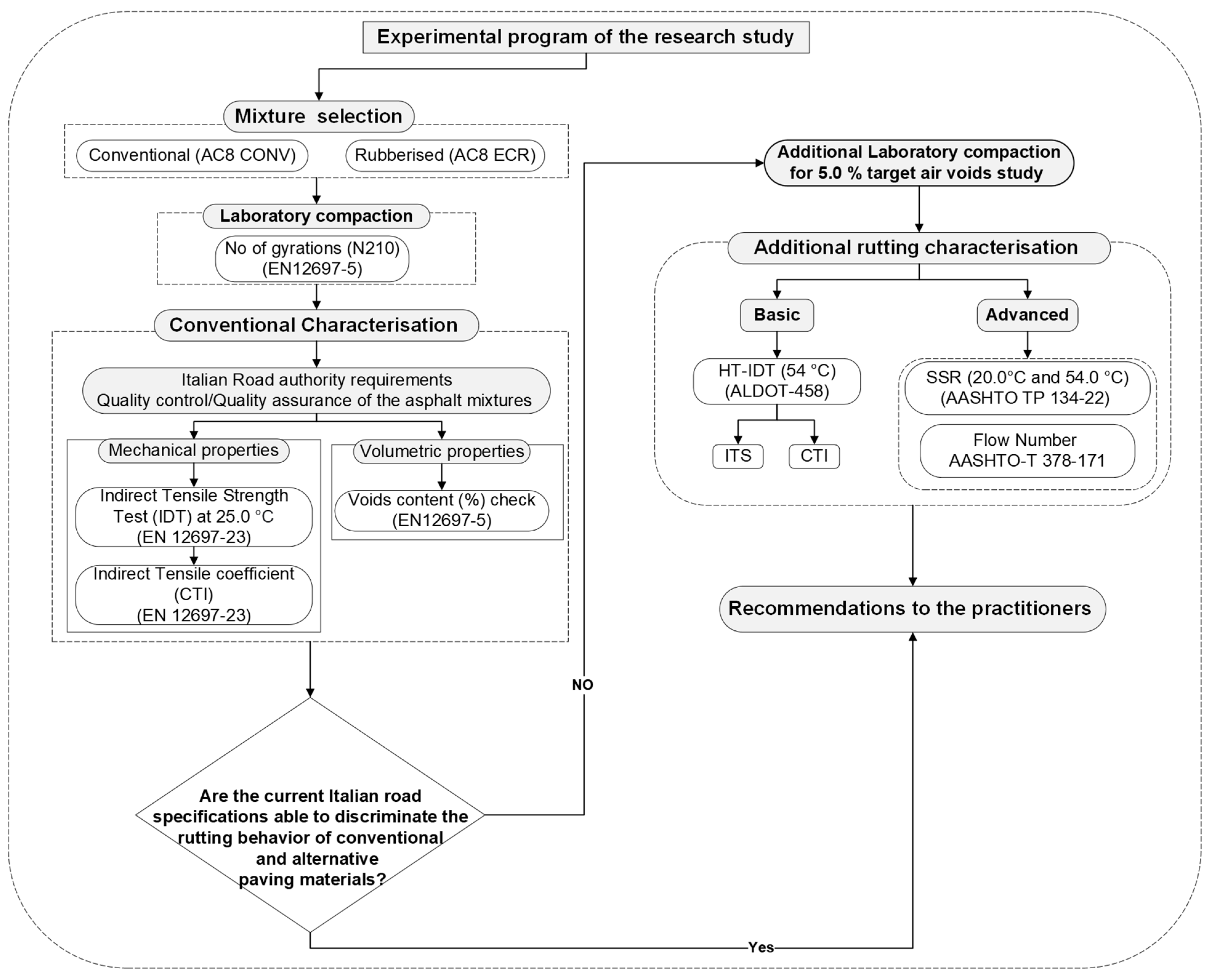

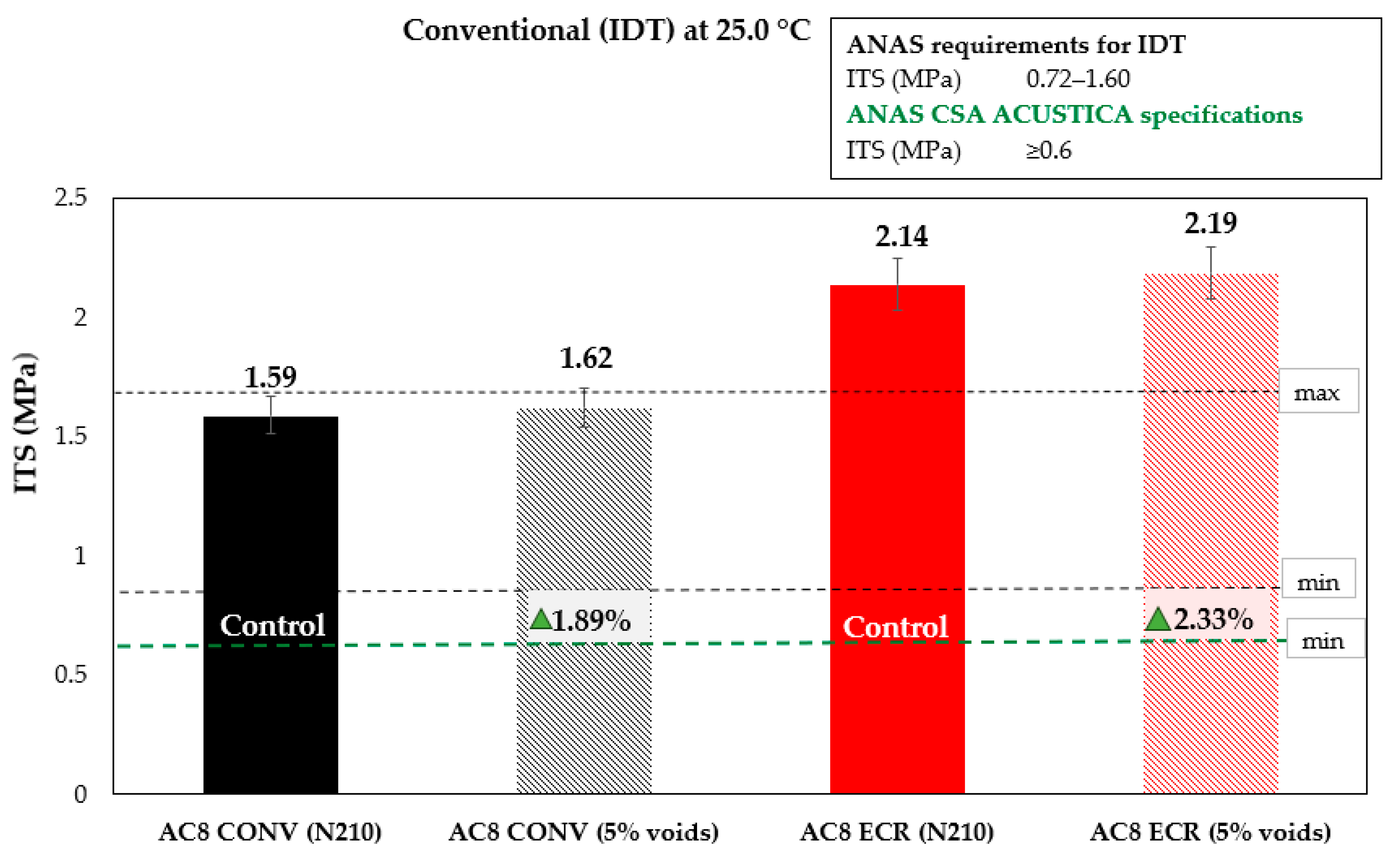



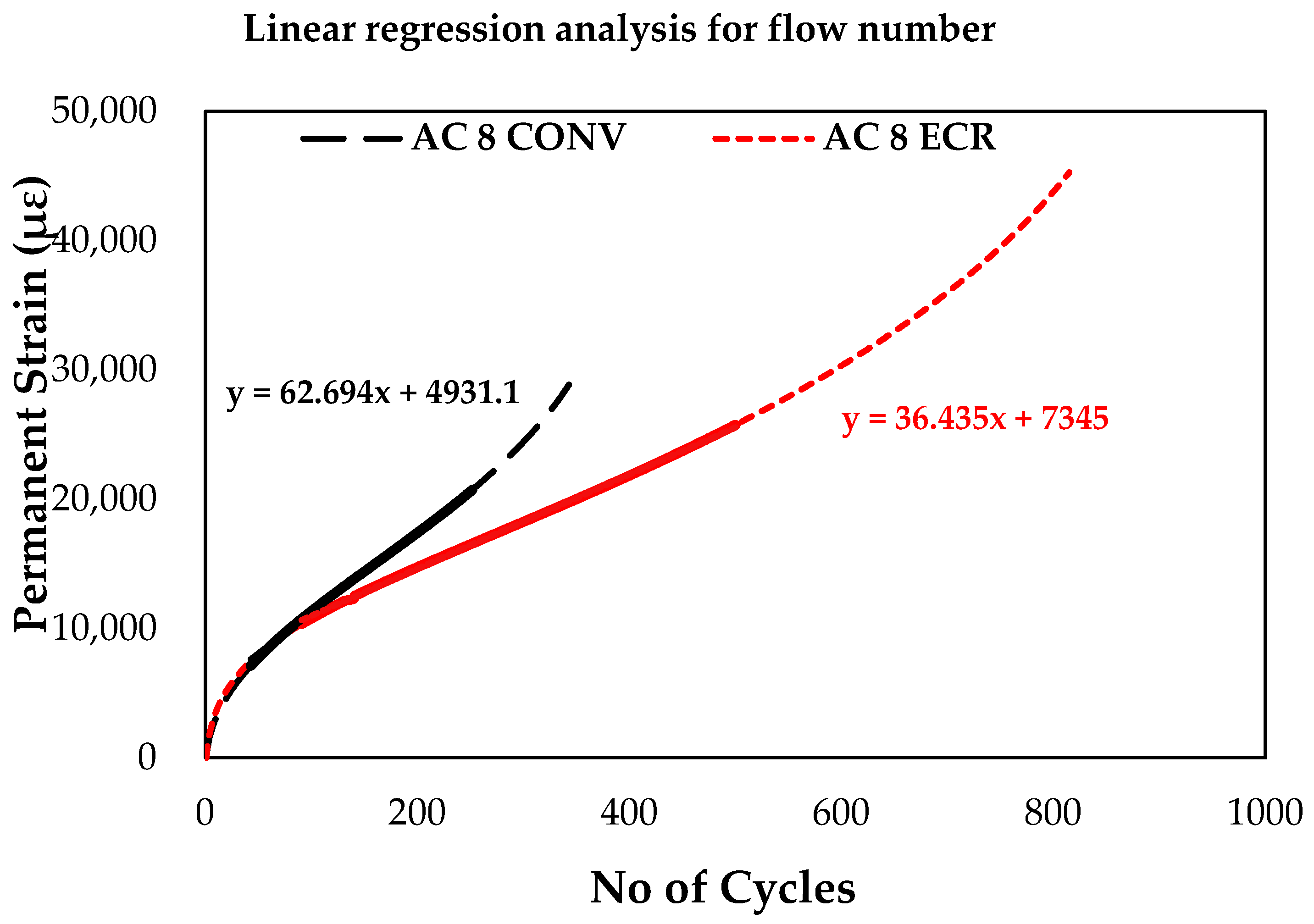
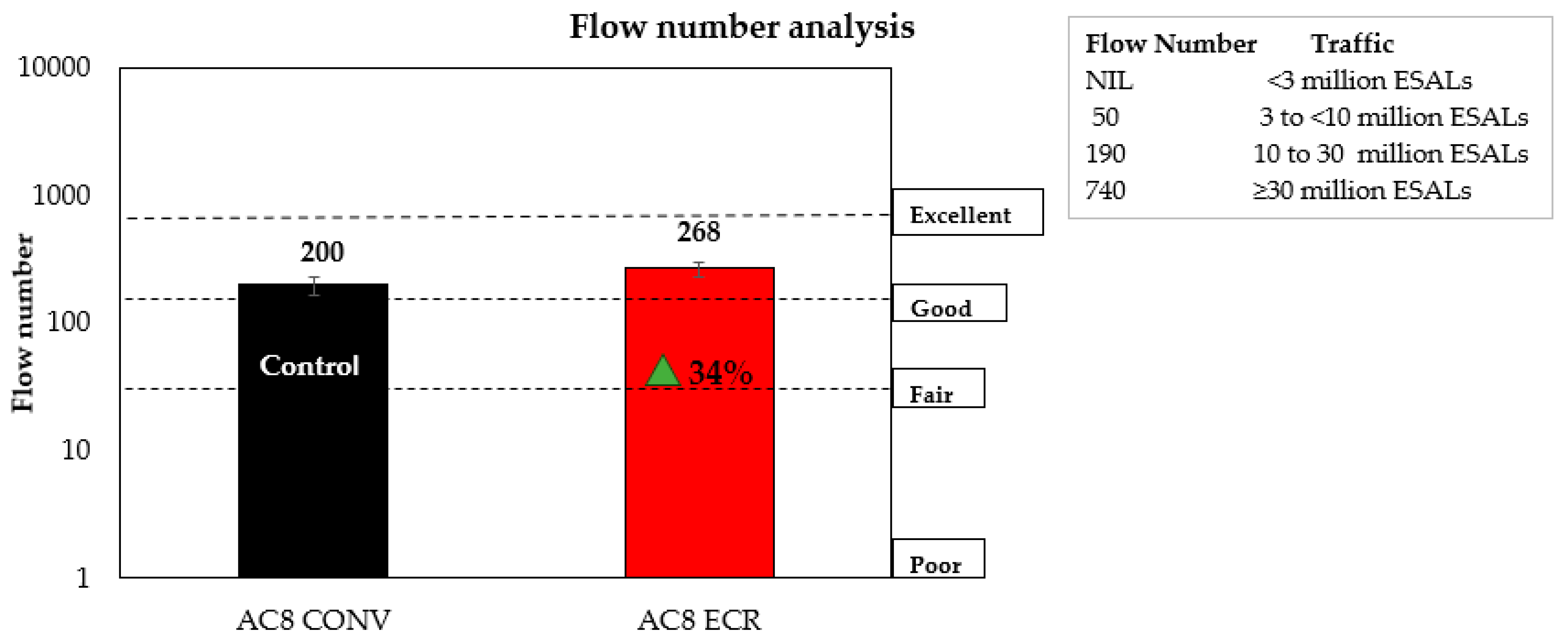
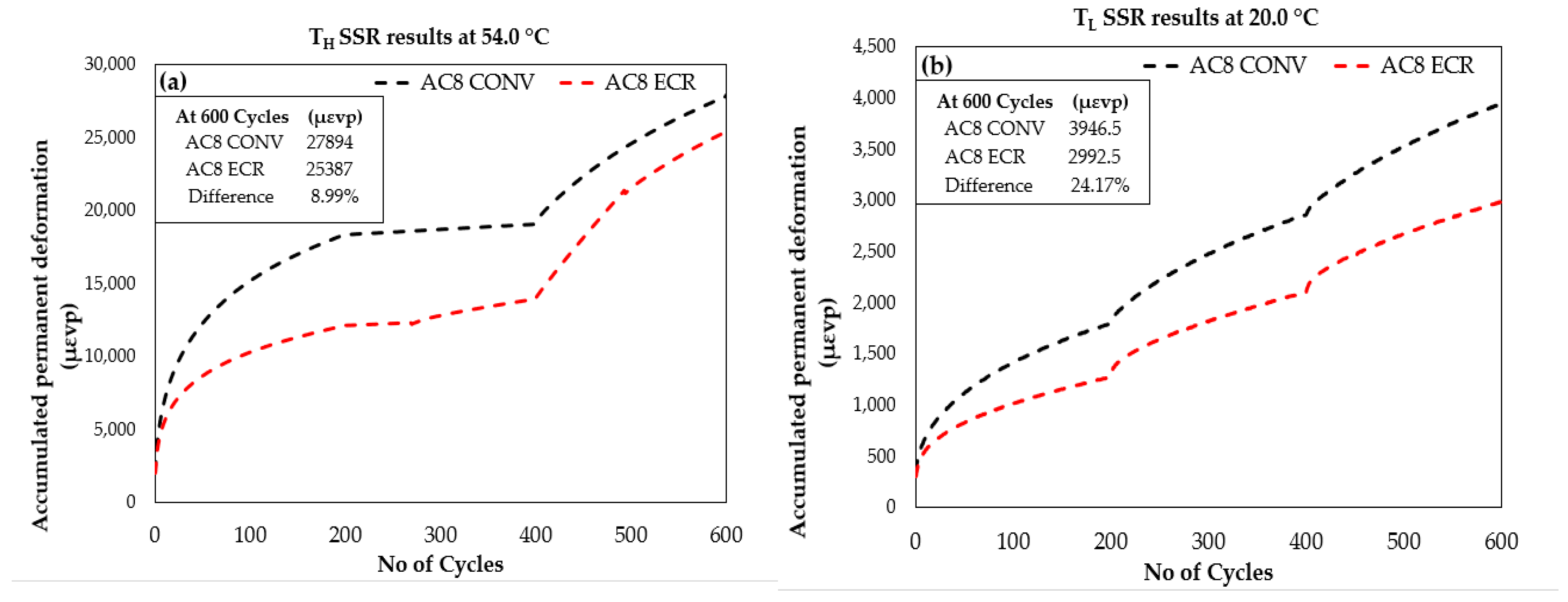
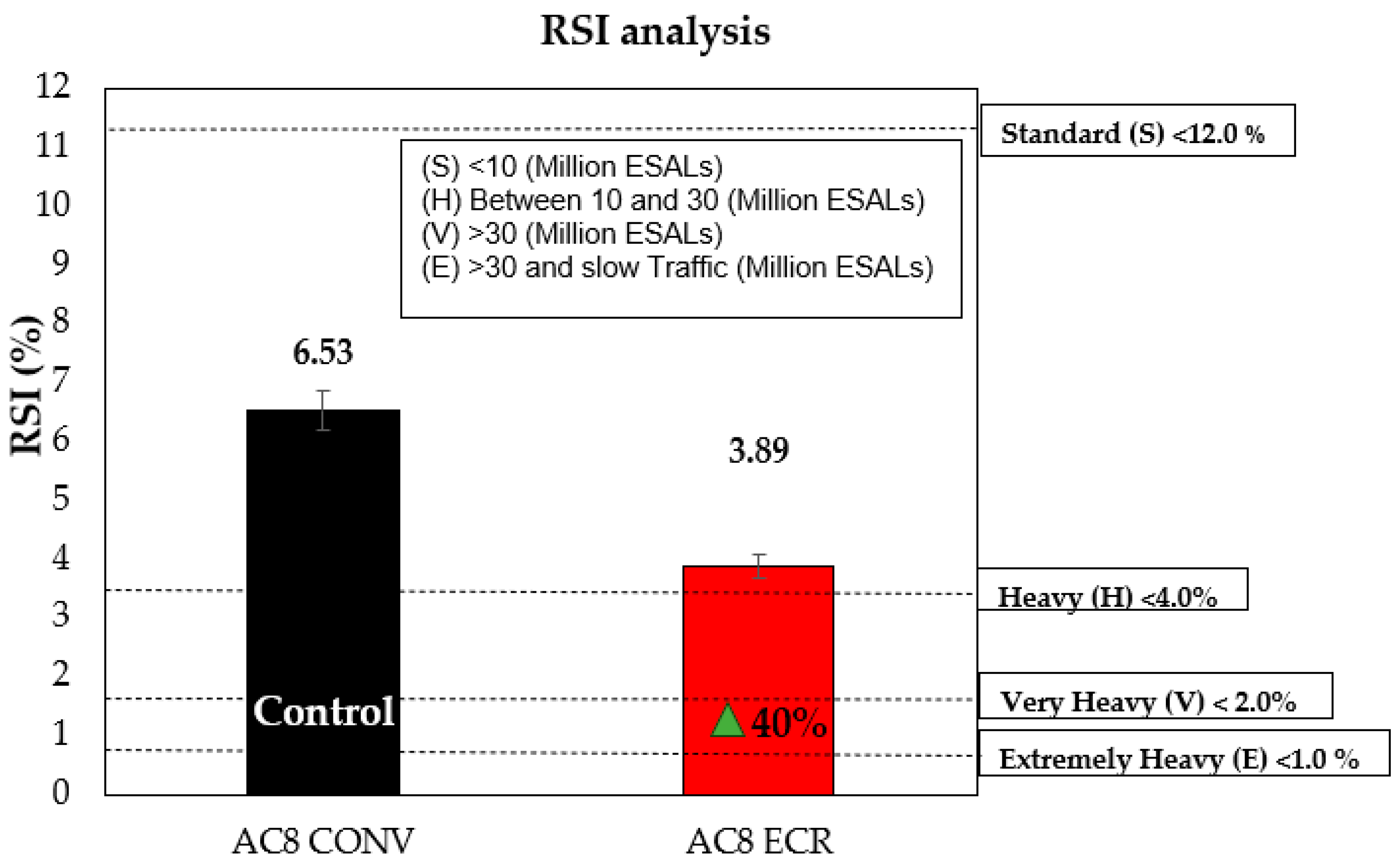
| Mixtures | Binder Type | Asphalt Binder Content (%) | Rubber Content (%) | Target Air Voids (%) |
|---|---|---|---|---|
| AC8 CONV | 50/70 | 4.80 | - | 5.0 |
| AC8 ECR | 50/70 | 5.20 | 0.50 | 5.0 |
| Characterisation | Property | Benchmark Values | Standards/Specifications | Reference (s) | |
|---|---|---|---|---|---|
| Conventional (QA/QC—Italian road authorities) | No. of gyrations | Void content (%) | |||
| Void content check | N10 | 11–15 | UNI EN 12697-5/ANAS | [25] | |
| N120 | 3–6 | ||||
| N210 | ≥2 | ||||
| Indirect tensile strength at 25.0 °C | ITS (MPa) | 0.72–1.60 | UNI EN 12697-23/ANAS | [25] | |
| ITS (MPa) | ≥0.6 | ||||
| Indirect tensile coefficient at 25.0 °C | CTI (MPa) | ≥65 | UNI EN 12697-23/ANAS | [25] | |
| CTI (MPa) | 50–150 | ||||
| Characterization Level | Standard | Parameter | Performance | |
|---|---|---|---|---|
| Basic (rutting resistance) | ALDOT-458 | HT-ITS (MPa) | >0.44 | Excellent |
| 0.32 ≤ 0.44 | Good | |||
| 0.20 ≤ 0.32 | Fair | |||
| ≤0.20 | Poor | |||
| Advanced | AASHTO T378-171 | Flow number (FN) | Traffic (106 ESALs) | Minimum FN |
| (rutting resistance) | <3 | - | ||
| 3 to <10 | 50 | |||
| 10 to <30 | 190 | |||
| ≥30 | 740 | |||
| AASHTO TP 134-22 | Rutting strain index (RSI) | Traffic (106 ESALs) | RSI (%) | |
| <10 | <12 (S) | |||
| 10 to 30 | <4.0 (H) | |||
| >30 | <2.0 (V) | |||
| ≥30 slow traffic | <1.0 (E) | |||
| Trends in Characterization of Conventional and Rubberized Asphalt Mixes | ||||||
|---|---|---|---|---|---|---|
| Mixture Type | ||||||
| Characterization type | Test type | Test parameter | Test temperature (°C) | AC8 CONV (Control) | AC8 ECR (Rubberized) | Trend |
| Conventional QA/QC—Italian road authority requirements | IDT | ITS | 25.0 | 1.62 MPa | 2.19 MPa | 35% (=) |
| CTI | 25.0 | 77.51 MPa | 131.71 MPa | ++ 70% | ||
| Basic (rutting behavior) | HT-IDT | ITS | 54.0 | 0.15 MPa | 0.26 MPa | ++ 73% |
| CTI | 54.0 | 9.13 MPa | 16.22 MPa | ++ 77% | ||
| Advanced (rutting behavior) | FN | 54.0 | 200 | 268 | = 35% | |
| SSR (RSI) | 20.0 and 54.0 | 6.53% | 3.89% | + 40% | ||
Disclaimer/Publisher’s Note: The statements, opinions and data contained in all publications are solely those of the individual author(s) and contributor(s) and not of MDPI and/or the editor(s). MDPI and/or the editor(s) disclaim responsibility for any injury to people or property resulting from any ideas, methods, instructions or products referred to in the content. |
© 2024 by the authors. Licensee MDPI, Basel, Switzerland. This article is an open access article distributed under the terms and conditions of the Creative Commons Attribution (CC BY) license (https://creativecommons.org/licenses/by/4.0/).
Share and Cite
Ghani, U.; Milazzo, S.; Giancontieri, G.; Buttitta, G.; Gu, F.; Presti, D.L. Investigating the Ability of Road Specifications to Discriminate the Rutting Behavior of Rubberized Asphalt Mixtures in Italy. Infrastructures 2024, 9, 113. https://doi.org/10.3390/infrastructures9070113
Ghani U, Milazzo S, Giancontieri G, Buttitta G, Gu F, Presti DL. Investigating the Ability of Road Specifications to Discriminate the Rutting Behavior of Rubberized Asphalt Mixtures in Italy. Infrastructures. 2024; 9(7):113. https://doi.org/10.3390/infrastructures9070113
Chicago/Turabian StyleGhani, Usman, Silvia Milazzo, Gaspare Giancontieri, Gabriella Buttitta, Fan Gu, and Davide Lo Presti. 2024. "Investigating the Ability of Road Specifications to Discriminate the Rutting Behavior of Rubberized Asphalt Mixtures in Italy" Infrastructures 9, no. 7: 113. https://doi.org/10.3390/infrastructures9070113
APA StyleGhani, U., Milazzo, S., Giancontieri, G., Buttitta, G., Gu, F., & Presti, D. L. (2024). Investigating the Ability of Road Specifications to Discriminate the Rutting Behavior of Rubberized Asphalt Mixtures in Italy. Infrastructures, 9(7), 113. https://doi.org/10.3390/infrastructures9070113









